Impact of Fires at Illegal Waste Storage Sites on Soil Contamination—A Study of Five Cases from Poland
Abstract
:1. Introduction
- What substances are generated during fires at illegal waste storage sites, which often contain hazardous substances?
- At what distance from the source of contamination does the content of substances generated during a fire in the soil drop the values permitted by the standards?
- Whether a correlation be found between the type of waste stored and the pollutants generated?
2. Materials and Methods
2.1. Study Area
2.2. Analysis of Samples of Ash from Waste Incineration and Soil in the Vicinity of the Fire Site
2.3. Physicochemical Analyses of Samples of Waste Incineration Ash and Soil in the Vicinity of Illegal Landfills
2.4. Statistical Analysis
3. Results and Discussion
3.1. Analysis of Selected Trace Elements in Ash Samples from Wildfires and Illegal Waste Dumps
3.2. Content of Selected Compounds in Samples of Ash from Wildfires and Illegal Dumps
3.3. HCA Analysis
3.4. PCA Analysis
3.5. Content of Selected Compounds in Soil Samples at Different Distances from Illegal Waste Storage Site
4. Conclusions
Author Contributions
Funding
Institutional Review Board Statement
Informed Consent Statement
Data Availability Statement
Conflicts of Interest
References
- Du, L.; Xu, H.; Zuo, J. Status quo of illegal dumping research: Way forward. J. Environ. Manag. 2021, 290, 112601. [Google Scholar] [CrossRef]
- Seror, N.; Portnov, B.A. Estimating the effectiveness of different environmental law enforcement policies on illegal C&D waste dumping in Israel. Waste Manag. 2020, 102, 241–248. [Google Scholar] [CrossRef] [PubMed]
- Yang, W.; Fan, B.; Desouza, K.C. Spatial-temporal effect of household solid waste on illegal dumping. J. Clean. Prod. 2019, 227, 313–324. [Google Scholar] [CrossRef]
- Øygard, J.K.; Måge, A.; Gjengedal, E.; Svane, T. Effect of an uncontrolled fire and the subsequent fire fight on the chemical composition of landfill leachate. Waste Manag. 2005, 25, 712–718. [Google Scholar] [CrossRef]
- Moqbel, S.Y. Characterizing Spontaneous Fires in Landfills. Electron. Theses Diss. 2009, 3855, 9–11. Available online: https://stars.library.ucf.edu/etd/3855 (accessed on 30 September 2021).
- Bihałowicz, J.S.; Rogula-Kozłowska, W.; Krasuski, A.; Salamonowicz, Z. The critical factors of landfill fire impact on air quality. Environ. Res. Lett. 2021, 16, 104026. [Google Scholar] [CrossRef]
- Ruokojärvi, P.; Ruuskanen, J.; Ettala, M.; Rahkonen, P.; Tarhanen, J. Formation of polyaromatic hydrocarbons and polychlorinated organic compounds in municipal waste landfill fires. Chemosphere 1995, 31, 3899–3908. [Google Scholar] [CrossRef]
- Environment, Central Statistical Office. Available online: https://stat.gov.pl/en/topics/environment-energy/environment/environment-2021,1,13.html (accessed on 30 September 2021).
- Šedová, B. On causes of illegal waste dumping in Slovakia. J. Environ. Plan. Manag. 2016, 59, 1277–1303. [Google Scholar] [CrossRef]
- Vassiliadou, I.; Papadopoulos, A.; Costopoulou, D.; Vasiliadou, S.; Christoforou, S.; Leondiadis, L. Dioxin contamination after an accidental fire in the municipal landfill of Tagarades, Thessaloniki, Greece. Chemosphere 2009, 74, 879–884. [Google Scholar] [CrossRef]
- Morales, S.R.G.; Toro, A.R.; Morales, L.; Leiva, G.M.A. Landfill fire and airborne aerosols in a large city: Lessons learned and future needs. Air Qual. Atmos. Health 2018, 11, 111–121. [Google Scholar] [CrossRef]
- Bihałowicz, J.S. Waste fires in Poland and some of Their Environmental Implications—A Ten-Year Perspective. J. Ecol. Eng. 2022, 23, 147–157. [Google Scholar] [CrossRef]
- Juan, W.-Y.; Wu, C.-L.; Liu, F.-W.; Chen, W.-S. Fires in Waste Treatment Facilities: Challenges and Solutions from a Fire Investigation Perspective. Sustainability 2023, 15, 9756. [Google Scholar] [CrossRef]
- Lemieuxa, P.M.; Lutesb, C.C.; Santoianni, D.A. Emissions of organic air toxics from open burning: A comprehensive review. Prog. Energy Combust. Sci. 2004, 30, 1–32. [Google Scholar] [CrossRef]
- Raudonytė-Svirbutavičienė, E.; Stakėnienė, R.; Jokšas, K.; Valiulis, D.; Byčenkienė, S.; Žarkov, A. Distribution of polycyclic aromatic hydrocarbons and heavy metals in soil following a large tire fire incident: A case study. Chemosphere 2022, 286, 131556. [Google Scholar] [CrossRef] [PubMed]
- White, P.A. The genotoxicity of priority polycyclic aromatic hydrocarbons in complex mixtures. Mutat. Res.—Genet. Toxicol. Environ. Mutagen. 2002, 515, 85–98. [Google Scholar] [CrossRef] [PubMed]
- Adetona, O.; Ozoh, O.B.; Oluseyi, T.; Uzoegwu, Q.; Odei, J.; Lucas, M. An exploratory evaluation of the potential pulmonary, neurological and other health effects of chronic exposure to emissions from municipal solid waste fires at a large dumpsite in Olusosun, Lagos, Nigeria. Environ. Sci. Pollut. Res. 2020, 27, 30885–30892. [Google Scholar] [CrossRef]
- Kodros, J.K.; Wiedinmyer, C.; Ford, B.; Cucinotta, R.; Gan, R.; Magzamen, S.; Pierce, J.R. Global burden of mortalities due to chronic exposure to ambient PM2.5 from open combustion of domestic waste. Environ. Res. Lett. 2016, 11, 124022. [Google Scholar] [CrossRef]
- Chrysikou, L.; Gemenetzis, P.; Kouras, A.; Manoli, E.; Terzi, E.; Samara, C. Distribution of persistent organic pollutants, polycyclic aromatic hydrocarbons and trace elements in soil and vegetation following a large scale landfill fire in northern Greece. Environ. Int. 2008, 34, 210–225. [Google Scholar] [CrossRef]
- Weichenthal, S.; Van Rijswijk, D.; Kulka, R.; You, H.; Van Ryswyk, K.; Willey, J.; Dugandzic, R.; Sutcliffe, R.; Moulton, J.; Baike, M.; et al. The impact of a landfill fire on ambient air quality in the north: A case study in Iqaluit, Canada. Environ. Res. 2015, 142, 46–50. [Google Scholar] [CrossRef]
- Rykała, W.; Fabiańska, M.J.; Dąbrowska, D. The Influence of a Fire at an Illegal Landfill in Southern Poland on the Formation of Toxic Compounds and Their Impact on the Natural Environment. Int. J. Environ. Res. Public Health 2022, 19, 13613. [Google Scholar] [CrossRef]
- Nadal, M.; Rovira, J.; Díaz-Ferrero, J.; Schuhmacher, M.; Domingo, J.L. Human exposure to environmental pollutants after a tire landfill fire in Spain: Health risks. Environ. Int. 2016, 97, 37–44. [Google Scholar] [CrossRef] [PubMed]
- Escobar-Arnanz, J.; Mekni, S.; Blanco, G.; Eljarrat, E.; Barceló, D.; Ramos, L. Characterization of organic aromatic compounds in soils affected by an uncontrolled tire landfill fire through the use of comprehensive two-dimensional gas chromatography–time-of-flight mass spectrometry. J. Chromatogr. A 2018, 1536, 163–175. [Google Scholar] [CrossRef] [PubMed]
- Hogland, W.; Marques, M.; Björklund, B. Fires in organic waste storages: Prevention, fire fighting and after care. In Proceedings of the 2007: Proceedings from Kalmar ECO-TECH’07: Technologies for Waste and Wastewater Treatment, Energy from Wast, Remediation of Contaminated Sited, Emissions Related to Climate, Kalmar, Sweden, 26–28 November 2007. [Google Scholar] [CrossRef]
- Tomczyk, P.; Wiatkowski, M. Impact of a small hydropower plant on water quality dynamics in a diversion and natural river channel. J. Environ. Qual. 2021, 50, 1156–1170. [Google Scholar] [CrossRef] [PubMed]
- PN EN ISO 11969: 1999; Water Quality—Determination Of Arsenic—Atomic Absorption Spectrometric Method (Hydride Technique). Polish Committee for Standardization: Warszawa, Poland, 1999.
- PN-EN 12457-4:2006; Characterization of waste—Leaching—Compliance Test for Leaching of Granular Waste Materials and Sludges—Part 4: One Stage Batch Test At a Liquid to Solid Ratio of 10 l/kg for Materials with Particle Size Below 10 mm (without or with Size Reduction). Polish Committee for Standardization: Warszawa, Poland, 2013.
- PN-EN ISO 11885:2009; Water Quality—Determination of Selected Elements by Inductively Coupled Plasma Optical Emission Spectrometry (ICP-OES). European Standards: Bruxelles, Belgium, 2009.
- PN-EN ISO 22155:2016-07; Gas Chromatographic Determination of Volatile Aromatic and Halogenated Hydrocarbons and Selected Ethers. ISO: Geneva, Switzerland, 2016.
- PN-ISO 10382:2007; Determination of Organochlorine Pesticides and Polychlorinated Biphenyls. ISO: Geneva, Switzerland, 2002.
- PN-EN 14039:2008; Characterization of Waste—Determination of Hydrocarbon Content in the Range of c[10] to c[40] by Gas Chromatography. Polish Committee for Standardization: Warszawa, Poland, 2013.
- Nell, C.; Schenck, C.; Blaauw, D.; Grobler, L.; Viljoen, K. A three-pronged approach to waste composition determination. J. Environ. Manag. 2022, 303, 114203. [Google Scholar] [CrossRef]
- Dabrowska, D.; Rykala, W.; Nourani, V. Causes, Types and Consequences of Municipal Waste Landfill Fires—Literature Review. Sustainability 2023, 15, 5713. [Google Scholar] [CrossRef]
- Hazrat, A.; Ezzat, K.; Ilahi, I. Environmental Chemistry and Ecotoxicology of Hazardous Heavy Metals: Environmental Persistence, Toxicity, and Bioaccumulation. J. Chem. 2019, 2019, 6730305. [Google Scholar]
- Luo, H.; Cheng, Y.; He, D.; Yang, E. Review of leaching behavior of municipal solid waste incineration. Sci. Total Environ. 2019, 668, 90–103. [Google Scholar] [CrossRef]
- Filipponi, P.; Polettini, A.; Pomi, R.; Sirini, P. Physical and mechanical properties of cement-based products containing incineration bottom ash. Waste Manag. 2003, 23, 145–156. [Google Scholar] [CrossRef]
- Mazza, A.; Piscitelli, P.; Neglia, C.; Rosa, G.D.; Iannuzzi, L. Illegal dumping of toxic waste and its effect on human health in Campania, Italy. Int. J. Environ. Res. Public Health 2015, 12, 6818–6831. [Google Scholar] [CrossRef]
- Tomaškinová, J.; Tomaškin, J. Assessment of anthropogenic activity negative impact on the karst landscape and a proposal for revitalization measures. Carpathian J. Earth Environ. Sci. 2014, 9, 117–123. [Google Scholar]
- Staley, B.F.; Xu, F.; Cowie, S.J.; Barlaz, M.A.; Hater, G.R. Release of trace organic compounds during the decomposition of municipal solid waste components. Environ. Sci. Technol. 2006, 40, 5984–5991. [Google Scholar] [CrossRef] [PubMed]
- Liu, Y.; Liu, Y.; Yang, H.; Wang, Q.; Cheng, F.; Lu, W.; Wang, J. Occupational health risk assessment of BTEX in municipal solid waste landfill based on external and internal exposure. J. Environ. Manag. 2022, 305, 114348. [Google Scholar] [CrossRef] [PubMed]
- Margesin, R.; Walder, G.; Schinner, F. Bioremediation assessment of a BTEX-contaminated soil. Acta Biotechnol. 2003, 23, 29–36. [Google Scholar] [CrossRef]
- Hamdi, N.; Srasra, E. Hydraulic conductivity study of compacted clay soils used as landfill liners for an acidic waste. Waste Manag. 2013, 33, 60–66. [Google Scholar] [CrossRef] [PubMed]
- Zhao, X.; Ma, L. Hazardous waste treatment for spent pot liner. In IOP Conference Series: Earth and Environmental Science; IOP Publishing: Bristol, UK, 2018; Volume 108, p. 042023. [Google Scholar] [CrossRef]
- Terzi, E.; Samara, C. Dry deposition of polycyclic aromatic hydrocarbons in urban and rural sites of Western Greece. Atmos. Environ. 2005, 39, 6261–6270. [Google Scholar] [CrossRef]
- Sinha, R.K.; Chandran, V.; Soni, B.K.; Patel, U.; Ghosh, A. Earthworms: Nature’s chemical managers and detoxifying agents in the environment: An innovative study on treatment of toxic wastewaters from the petroleum industry by vermifiltration technology. Environmentalist 2012, 32, 445–452. [Google Scholar] [CrossRef]
- Jager, T.; Baerselman, R.; Dijkman, E.; de Groot, A.C.; Hogendoorn, E.A.; de Jong, A.; Kruitbosch, J.A.W.; Peijnenburg, W.J.G.M. Availability of polycyclic aromatic hydrocarbons to earthworms (Eisenia andrei, Oligochaeta) in field-polluted soils and soil-sediment mixtures. Environ. Toxicol. Chem. 2003, 22, 767–775. [Google Scholar] [CrossRef]
- Durmusoglu, E.; Yilmaz, C. Evaluation and temporal variation of raw and pre-treated leachate quality from an active solid waste landfill. Water Air Soil Pollut. 2006, 171, 359–382. [Google Scholar] [CrossRef]
- Wdowczyk, A.; Szymańska-Pulikowska, A. Analysis of the possibility of conducting a comprehensive assessment of landfill leachate contamination using physicochemical indicators and toxicity test. Ecotoxicol. Environ. Saf. 2021, 221, 112434. [Google Scholar] [CrossRef]
- Wdowczyk, A.; Szymańska-Pulikowska, A. Micro- and Macroelements Content of Plants Used for Landfill Leachate Treatment Based on Phragmites australis and Ceratophyllum demersum. Int. J. Environ. Res. Public Health 2022, 19, 6035. [Google Scholar] [CrossRef] [PubMed]
- Wdowczyk, A.; Szymańska-Pulikowska, A. Effect of substrates on the potential of Phragmites australis to accumulate and translocate selected contaminants from landfill leachate. Water Resour. Ind. 2023, 29, 100203. [Google Scholar] [CrossRef]
- Quina, M.J.; Santos, R.C.; Bordado, J.C.; Quinta-Ferreira, R.M. Characterization of air pollution control residues produced in a municipal solid waste incinerator in Portugal. J. Hazard. Mater. 2008, 152, 853–869. [Google Scholar] [CrossRef] [PubMed]
- Lindberg, D.; Molin, C.; Hupa, M. Thermal treatment of solid residues from WtE units: A review. Waste Manag. 2015, 37, 82–94. [Google Scholar] [CrossRef]
- Pereira, P.; Cerdà, A.; Úbeda, H.; Mataix-Solera, J.; Arcenegui, V.; Zavala, Z.M. Modelling the Impacts of Wildfire on Ash Thickness in a Short-Term Period. Land Degrad. Dev. 2015, 26, 180–192. [Google Scholar] [CrossRef]


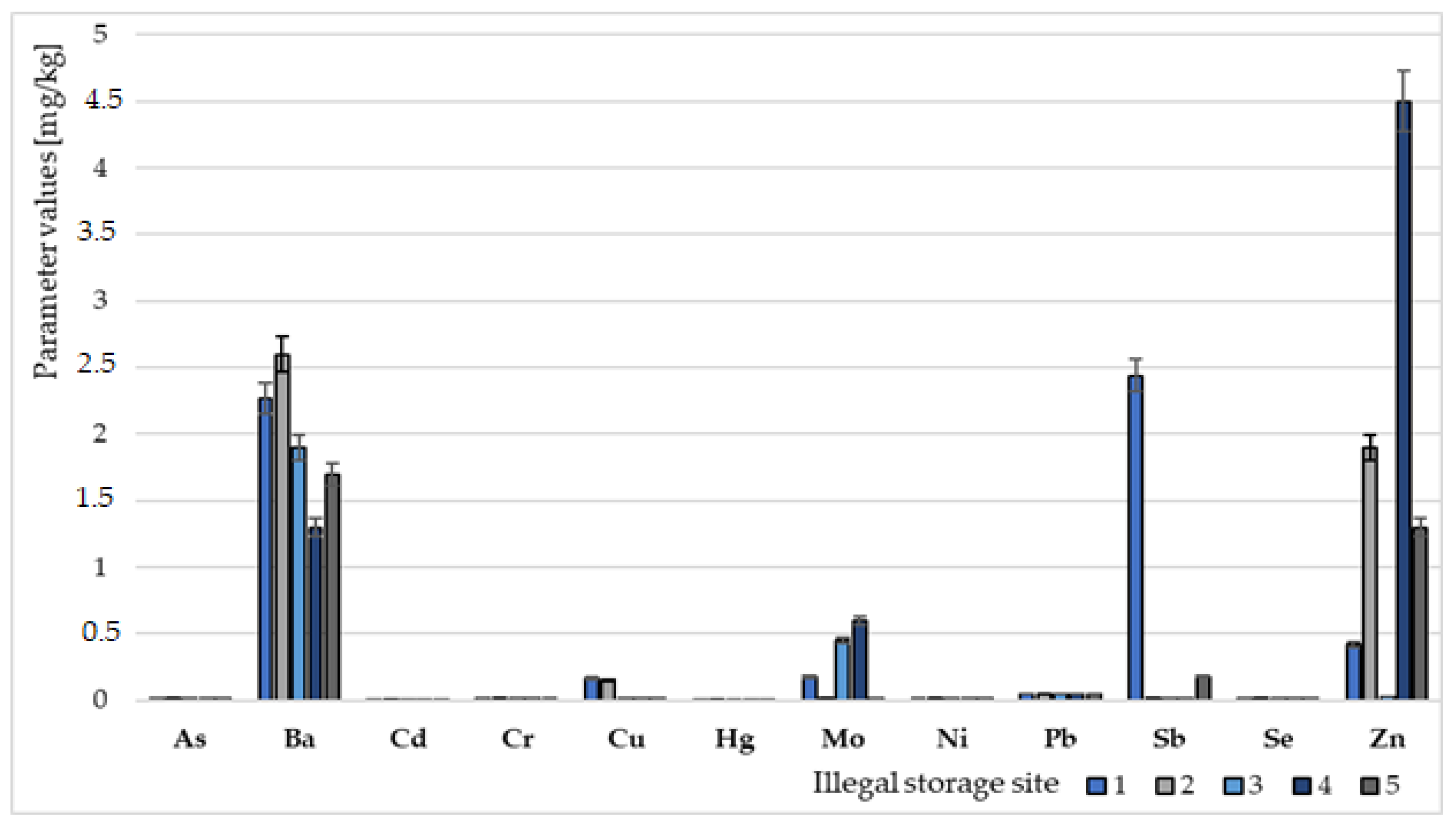
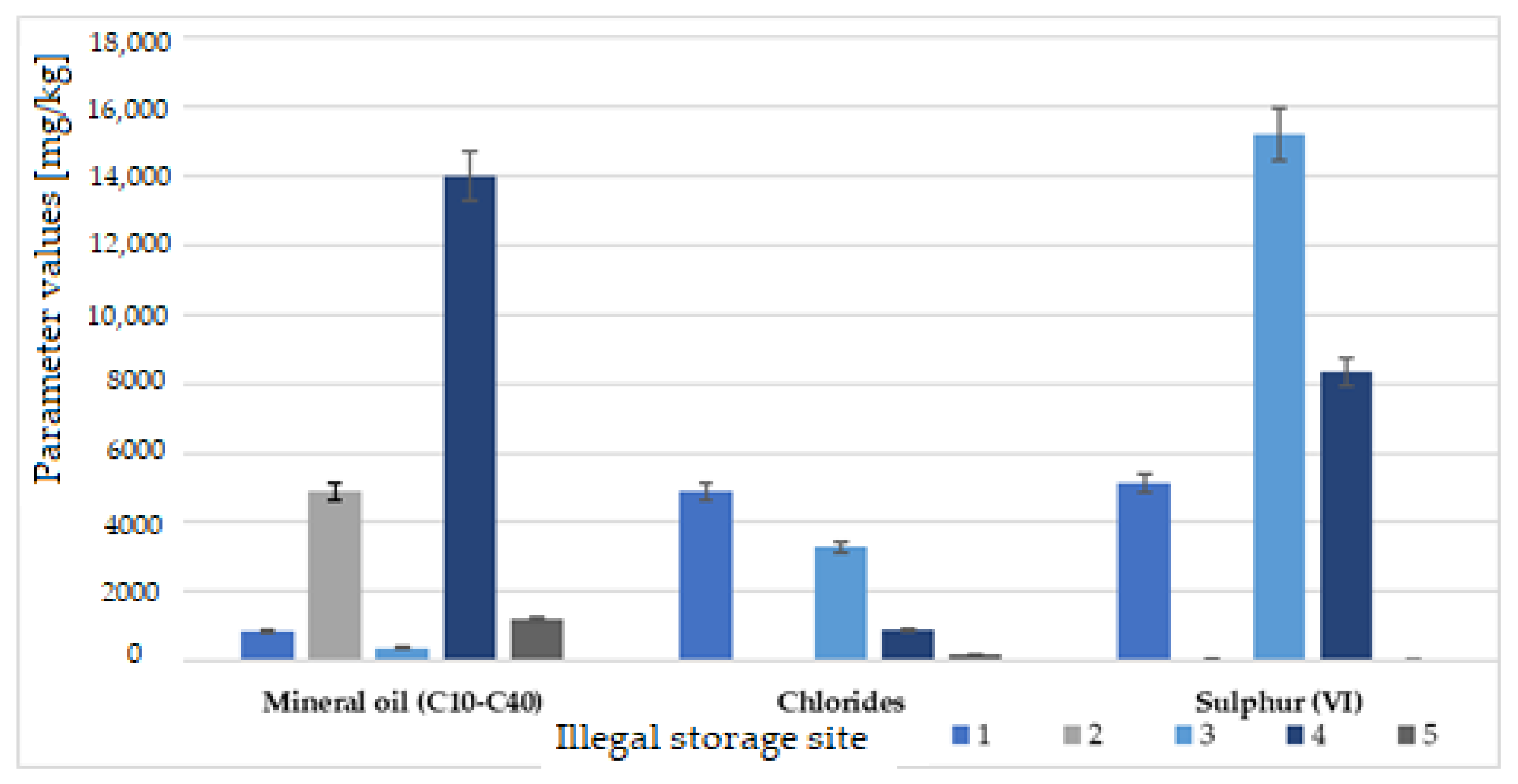
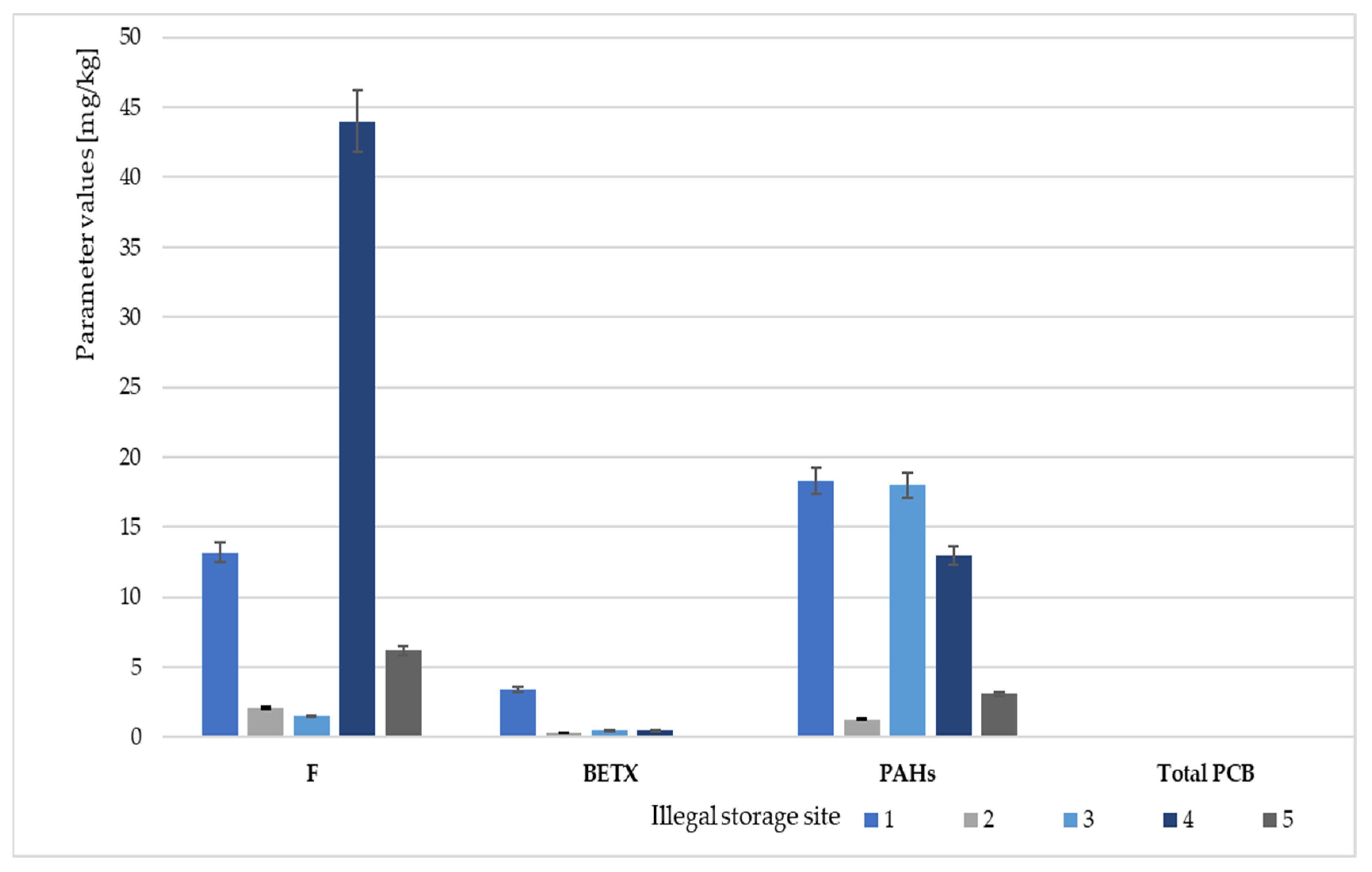

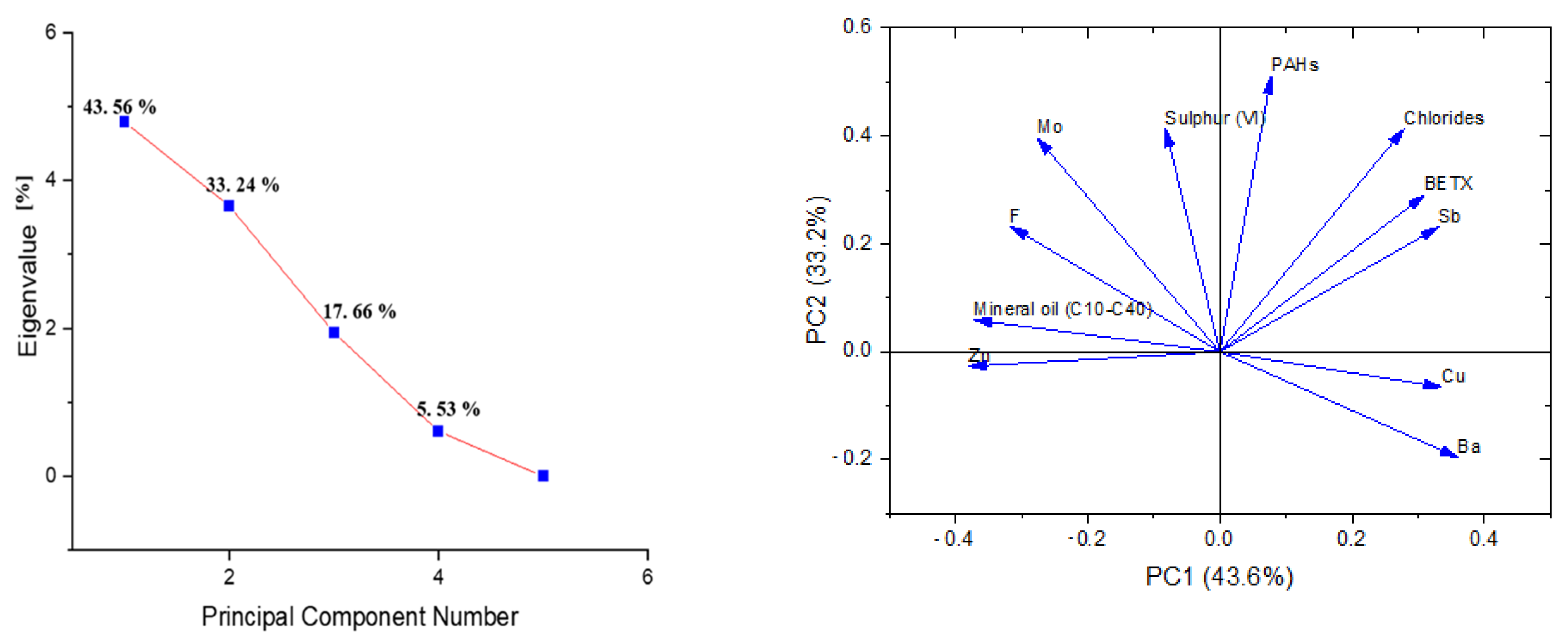

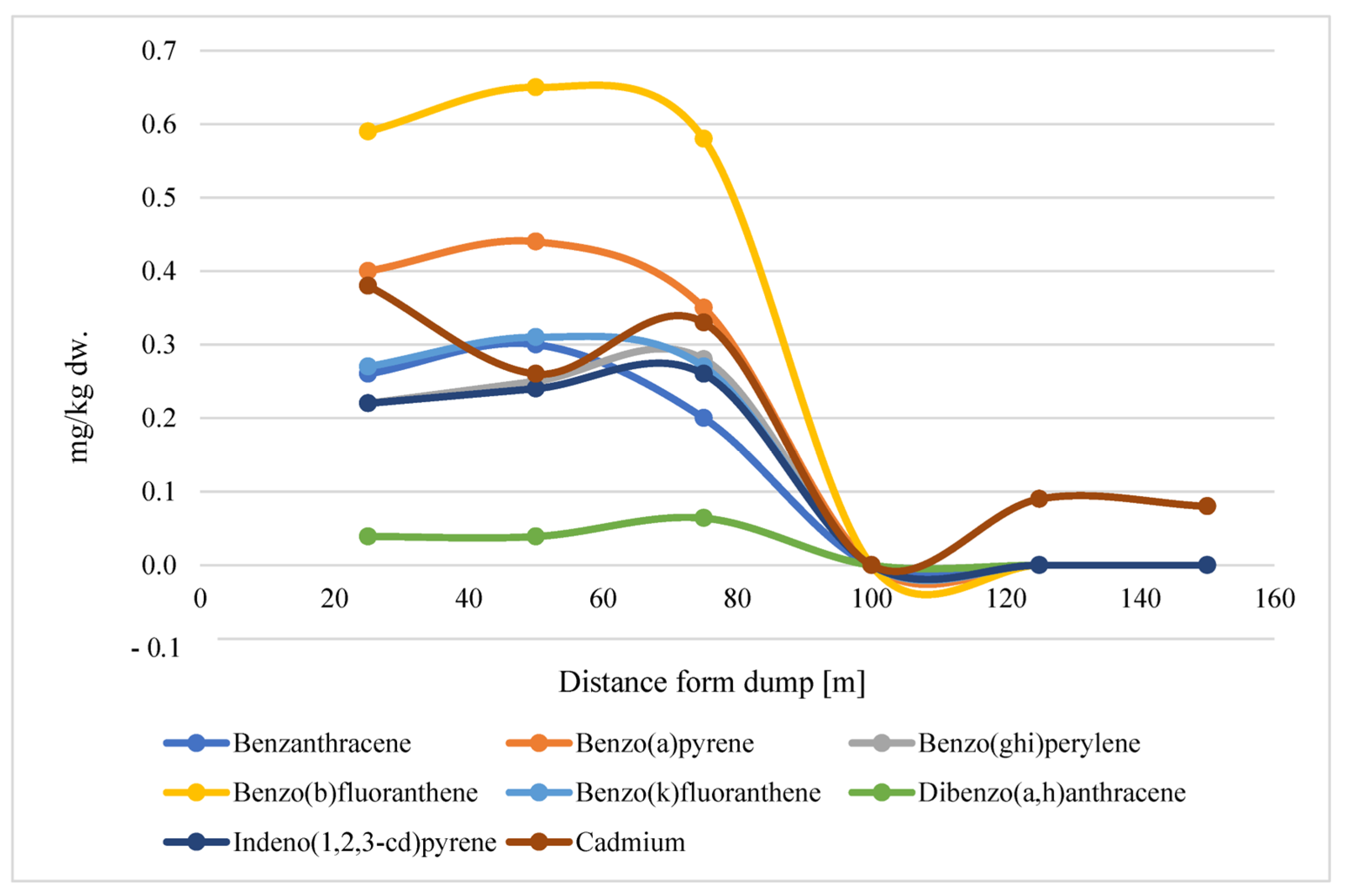
| Waste Storage Site | Estimated Area [ha] | Distance from Buildings [m] | Distance from Roads [m] | Location | Examples of Deposited Waste |
|---|---|---|---|---|---|
| Site 1 | 1 | 200 | 100 | 51°6′43.127″ N 16° 21′18.015″ E | asbestos (crushed Eternit), construction debris, barrels with remnants of unknown-origin oil, paint cans, rubber (car tires), electrical cable |
| Site 2 | 0.5 | 500 | 10 | 51°43′51.98″ N 16°42′15.15″ E | automotive parts, rims, burnt motor oil, body parts, car upholstery, paint cans, electrical cables |
| Site 3 | 0.2 | 100 | 300 | 51°9′23.078″ N 17°11′39.947″ E | car tires, asbestos (crushed Eternit), municipal waste, bags with agglomerated construction materials, colored glass, railway ties |
| Site 4 | 0.3 | 1500 | 500 | 51°7′20.96″ N 16°26′35.905″ E | bottles and packaging for plant protection products, PET bottles, roofing felt, agricultural foil |
| Site 5 | 0.3 | 1000 | 20 | 51°5′18.814″ N 19°14′18.552″ E | paint cans, tar, glass, PET bottles, debris, black plastic film, lacquered wood. |
| Detection Limit for the Tested Substance, mg/kg dw. | Research Method Characteristics—Legal Foundations |
|---|---|
| Arsenic (0.025–50) | |
| Barium (0.010–1000) | |
| Cadmium (0.005–5000) | |
| Chromium (0.030–5000) | |
| Copper (0.040–10,000) | |
| Mercury (0.010–10) | |
| Molybdenum (0.040–1000) | |
| Nickel (0.040–5000) | |
| Lead (0.10–5000) | |
| Antimony (0.025–10) | |
| Selenium (0.025–10) | PN-EN ISO 11969:1999, PN-EN 12457-4:2006 [26,27] |
| Zinc (0.050–10,000) | PN-EN ISO 11885:2009, PN-EN 12457-4:2006 [27,28] |
| Benzene (0.020–15) | |
| Toluene (0.020–15) | |
| Ethylbenzene (0.020–15) | |
| o-Xylene (0.020–15) | |
| Total Monoaromatic Hydrocarbons (BTEX) (from 0.020) | PN-EN ISO 22155:2016-07 [29] |
| PCB 101 (0.020–2.0) | PN-ISO 10382:2007 [30] |
| Mineral Oil (C10–C40 hydrocarbons) (20–20,000) | PN-EN 14039:2008 [31] |
Disclaimer/Publisher’s Note: The statements, opinions and data contained in all publications are solely those of the individual author(s) and contributor(s) and not of MDPI and/or the editor(s). MDPI and/or the editor(s) disclaim responsibility for any injury to people or property resulting from any ideas, methods, instructions or products referred to in the content. |
© 2023 by the authors. Licensee MDPI, Basel, Switzerland. This article is an open access article distributed under the terms and conditions of the Creative Commons Attribution (CC BY) license (https://creativecommons.org/licenses/by/4.0/).
Share and Cite
Kuta, Ł.; Hachoł, J.; Wdowczyk, A.; Hochman, J. Impact of Fires at Illegal Waste Storage Sites on Soil Contamination—A Study of Five Cases from Poland. Sustainability 2023, 15, 15645. https://doi.org/10.3390/su152115645
Kuta Ł, Hachoł J, Wdowczyk A, Hochman J. Impact of Fires at Illegal Waste Storage Sites on Soil Contamination—A Study of Five Cases from Poland. Sustainability. 2023; 15(21):15645. https://doi.org/10.3390/su152115645
Chicago/Turabian StyleKuta, Łukasz, Justyna Hachoł, Aleksandra Wdowczyk, and Julia Hochman. 2023. "Impact of Fires at Illegal Waste Storage Sites on Soil Contamination—A Study of Five Cases from Poland" Sustainability 15, no. 21: 15645. https://doi.org/10.3390/su152115645





